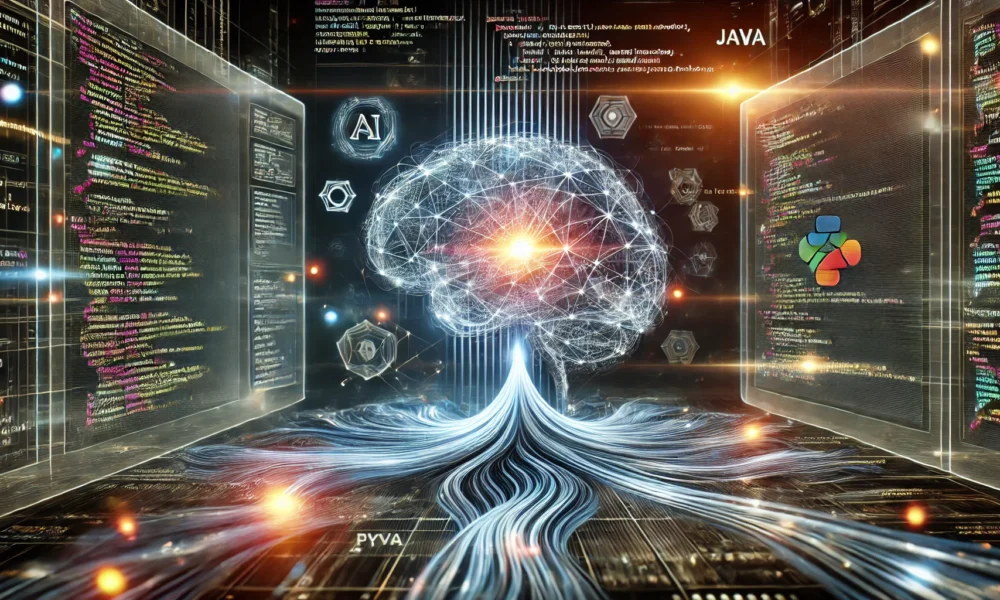Unlocking the Potential of Mixture-of-Experts in Language Models
In the realm of natural language processing (NLP), the drive to develop larger and more capable language models has fueled numerous advancements. However, as these models expand in size, the computational demands for training and inference grow exponentially, challenging available hardware resources.
Introducing Mixture-of-Experts (MoE), a technique that offers a solution to this computational burden while empowering the training of robust language models on a larger scale. In this informative blog, we will delve into the world of MoE, uncovering its origins, mechanisms, and applications within transformer-based language models.
### The Roots of Mixture-of-Experts
The concept of Mixture-of-Experts (MoE) dates back to the early 1990s, when researchers delved into conditional computation, a method where sections of a neural network are selectively activated based on input data. A seminal work in this domain was the “Adaptive Mixture of Local Experts” paper by Jacobs et al. in 1991, which put forth a supervised learning framework for a neural network ensemble, with each member specializing in a distinct input space region.
The fundamental principle behind MoE involves multiple “expert” networks tasked with processing designated input subsets. A gating mechanism, often implemented as a neural network, decides which expert(s) should handle a given input. This strategy enables efficient resource allocation by activating only relevant experts for each input, rather than engaging the entire model capacity.
Through the years, researchers have extended the concept of conditional computation, leading to developments like hierarchical MoEs, low-rank approximations for conditional computation, and methods for estimating gradients using stochastic neurons and hard-threshold activation functions.
### Mixture-of-Experts in Transformers
While MoE has existed for decades, its integration into transformer-based language models is a relatively recent development. Transformers, now the standard for cutting-edge language models, consist of multiple layers, each housing a self-attention mechanism and a feed-forward neural network (FFN).
The key innovation in applying MoE to transformers involves replacing dense FFN layers with sparse MoE layers comprising multiple expert FFNs and a gating mechanism. This gating mechanism dictates which expert(s) should process each input token, enabling selective activation of a subset of experts for a given input sequence.
One of the pioneering works demonstrating the potential of MoE in transformers was the 2017 paper “Outrageously Large Neural Networks: The Sparsely-Gated Mixture-of-Experts Layer” by Shazeer et al. This work introduced a sparsely-gated MoE layer that utilized a gating mechanism introducing sparsity and noise to the expert selection process, ensuring only a subset of experts were activated for each input.
Since then, several subsequent works have advanced the application of MoE in transformers, addressing challenges like training instability, load balancing, and efficient inference. Noteworthy examples include the Switch Transformer (Fedus et al., 2021), ST-MoE (Zoph et al., 2022), and GLaM (Du et al., 2022).
### The Benefits of Mixture-of-Experts for Language Models
The primary advantage of employing MoE in language models lies in the ability to scale up model size while maintaining a consistent computational cost during inference. By selectively activating a subset of experts for each input token, MoE models achieve the expressive power of larger dense models while demanding significantly less computation.
For instance, consider a language model featuring a dense FFN layer with 7 billion parameters. If this layer is replaced with an MoE layer comprising eight experts, each with 7 billion parameters, the total parameter count increases to 56 billion. Nevertheless, during inference, activating only two experts per token equates the computational cost to that of a 14 billion parameter dense model, as it processes two 7 billion parameter matrix multiplications.
This computational efficiency during inference proves particularly valuable in deployment scenarios with limited resources, such as mobile devices or edge computing environments. Additionally, reduced computational requirements during training can yield substantial energy savings and a lighter carbon footprint, aligning with the growing emphasis on sustainable AI practices.
### Challenges and Considerations
While MoE models offer compelling benefits, their adoption and deployment present several challenges and considerations:
1. Training Instability: MoE models are susceptible to training instabilities compared to their dense counterparts due to the sparse and conditional nature of expert activations. Techniques like the router z-loss have been proposed to mitigate these instabilities, but further research is warranted.
2. Finetuning and Overfitting: MoE models are prone to overfitting during finetuning, especially when the downstream task involves relatively small datasets. Careful regularization and finetuning strategies are crucial to address this issue.
3. Memory Requirements: MoE models may entail higher memory needs compared to dense models of similar size since all expert weights must be loaded into memory, even if only a subset is activated per input. Memory constraints can constrain the scalability of MoE models on resource-limited devices.
4. Load Balancing: Achieving optimal computational efficiency necessitates balancing the workload across experts to prevent overloading a single expert while others remain underutilized. Auxiliary losses during training and meticulous tuning of the capacity factor play a key role in load balancing.
5. Communication Overhead: In distributed training and inference settings, MoE models introduce additional communication overhead by requiring the exchange of activation and gradient information across experts located on various devices or accelerators. Efficient communication strategies and hardware-aware model design are essential for mitigating this overhead.
Despite these challenges, the potential benefits of MoE models in enabling larger and more capable language models have fueled extensive research endeavors to tackle and alleviate these issues.
### Example: Mixtral 8x7B and GLaM
To exemplify the practical application of MoE in language models, let’s focus on two notable instances: Mixtral 8x7B and GLaM.
Mixtral 8x7B represents an MoE variant of the Mistral language model developed by Anthropic. Comprising eight experts, each with 7 billion parameters, the model totals 56 billion parameters. Nonetheless, during inference, only two experts activate per token, reducing the computational cost to that of a 14 billion parameter dense model.
Mixtral 8x7B has showcased impressive performance, surpassing the 70 billion parameter Llama model while offering faster inference times. An instruction-tuned version dubbed Mixtral-8x7B-Instruct-v0.1 has also emerged, enhancing its ability to follow natural language instructions.
Another standout model is GLaM (Google Language Model), a large-scale MoE model crafted by Google. GLaM adopts a decoder-only transformer architecture and was trained on an extensive 1.6 trillion token dataset. The model delivers remarkable performance on few-shot and one-shot evaluations, matching GPT-3’s quality while requiring just one-third of the energy to train.
GLaM’s triumph is attributed to its efficient MoE architecture, enabling the training of a model with an extensive parameter count while maintaining reasonable computational demands. The model also underscores the potential of MoE models to be more energy-efficient and environmentally sustainable compared to their dense counterparts.
### The Grok-1 Architecture
Grok-1 emerges as a transformer-based MoE model boasting a distinctive architecture geared towards maximizing efficiency and performance. Let’s unpack the essential specifications:
1. **Parameters**: Grok-1 flaunts a monumental 314 billion parameters, making it the largest open LLM to date. Owing to the MoE design, merely 25% of the weights (roughly 86 billion parameters) are active at a given time, amplifying processing capabilities.
2. **Architecture**: Grok-1 leverages a Mixture-of-8-Experts design, with each token processed by two experts during inference.
3. **Layers**: The model comprises 64 transformer layers, each featuring multihead attention and dense blocks.
4. **Tokenization**: Grok-1 implements a SentencePiece tokenizer with a vocabulary of 131,072 tokens.
5. **Embeddings and Positional Encoding**: Featuring 6,144-dimensional embeddings, the model incorporates rotary positional embeddings, facilitating dynamic data interpretation vis-a-vis traditional fixed positional encodings.
6. **Attention**: Grok-1 utilizes 48 attention heads for queries and 8 for keys and values, each sized at 128.
7. **Context Length**: The model can process sequences up to 8,192 tokens in length, employing bfloat16 precision for efficient computation.
#### Performance and Implementation Details
Grok-1 has delivered outstanding performance, outshining LLaMa 2 70B and Mixtral 8x7B with an impressive MMLU score of 73%, underlining its efficiency and accuracy across diverse tests.
It should be noted that Grok-1 demands substantial GPU resources due to its sheer size. The current open-source implementation focuses on validating the model’s correctness and employs an inefficient MoE layer implementation to circumvent custom kernel requirements.
Nevertheless, the model supports activation sharding and 8-bit quantization, representing avenues to enhance performance and reduce memory requirements.
In a remarkable gesture, xAI has open-sourced Grok-1 under the Apache 2.0 license, granting global access to its weights and architecture for use and contributions.
The open-source release incorporates a JAX example code repository elucidating how to load and run the Grok-1 model. Users can obtain checkpoint weights via a torrent client or directly through the HuggingFace Hub, streamlining access to this groundbreaking model.
### The Future of Mixture-of-Experts in Language Models
As the demand escalates for larger and more adept language models, the adoption of MoE techniques is poised to gain momentum. Ongoing research endeavors center on addressing persistent challenges like boosting training stability, curbing overfitting during finetuning, and optimizing memory and communication needs.
An encouraging avenue is the investigation of hierarchical MoE architectures wherein each expert comprises multiple sub-experts. This approach could potentially amplify scalability and computational efficiency while upholding the expressive prowess of large models.
Furthermore, the development of hardware and software systems tailored for MoE models remains an active research domain. Specialized accelerators and distributed training frameworks calibrated to handle the sparse and conditional computation patterns of MoE models could bolster their performance and scalability.
Also, melding MoE techniques with other breakthroughs in language modeling such as sparse attention mechanisms, efficient tokenization strategies, and multi-modal representations could herald even more potent and versatile language models adept at handling a gamut of tasks.
### Conclusion
Mixture-of-Experts emerges as a robust tool in the endeavor to craft larger and more proficient language models. By activating experts selectively based on input data, MoE models offer an effective solution to the computational hurdles linked with scaling up dense models. While challenges like training instability, overfitting, and memory requirements persist, the potential perks of MoE models in terms of computational efficiency, scalability, and environmental conscientiousness make them a captivating arena for research and innovation.
As the landscape of natural language processing continues to redefine its limits, the integration of MoE techniques is poised to play a pivotal role in fostering the next wave of language models. By amalgamating MoE with other advancements in model architecture, training methodologies, and hardware optimization, we can anticipate the emergence of even more powerful and versatile language models, proficient in truly understanding and communicating with humans in a natural and seamless manner.
H2: What is the Rise of Mixture-of-Experts for Efficient Large Language Models?
H3: Definition and importance of Mixture-of-Experts in language models:
– Mixture-of-Experts is a technique in machine learning where multiple “expert” networks are combined into a single model to improve performance.
– This approach is crucial for large language models as it allows them to efficiently process and generate text by leveraging the strengths of different expert networks.
H2: How does Mixture-of-Experts improve the efficiency of large language models?
H3: Benefits of using Mixture-of-Experts in language models:
– Distributing workload: By dividing tasks among multiple expert networks, Mixture-of-Experts can speed up processing and improve performance in large language models.
– Specialization: Each expert network can focus on a specific aspect of language processing, leading to more accurate and contextually relevant outputs.
H2: What are some real-world applications of Mixture-of-Experts in language models?
H3: Examples of Mixture-of-Experts applications in language models:
– Language translation: Multilingual language models can benefit from using Mixture-of-Experts to improve translation accuracy and speed.
– Text generation: Generating coherent and relevant text output can be enhanced through the use of specialized expert networks in Mixture-of-Experts models.
H2: How can businesses leverage Mixture-of-Experts for their language processing needs?
H3: Implementing Mixture-of-Experts in business language models:
– Customization: Tailoring expert networks to specific business needs can result in more accurate and efficient language processing.
– Scalability: Mixture-of-Experts allows businesses to scale their language models without sacrificing performance, making it ideal for handling large amounts of text data.
H2: What are the future trends in Mixture-of-Experts for large language models?
H3: Emerging developments in Mixture-of-Experts for language models:
– Improving efficiency: Researchers are exploring new ways to optimize the combination of expert networks in Mixture-of-Experts models to further enhance performance.
– Integration with other AI techniques: Mixture-of-Experts may be combined with other machine learning methods to create even more powerful and versatile language processing models.
Source link










